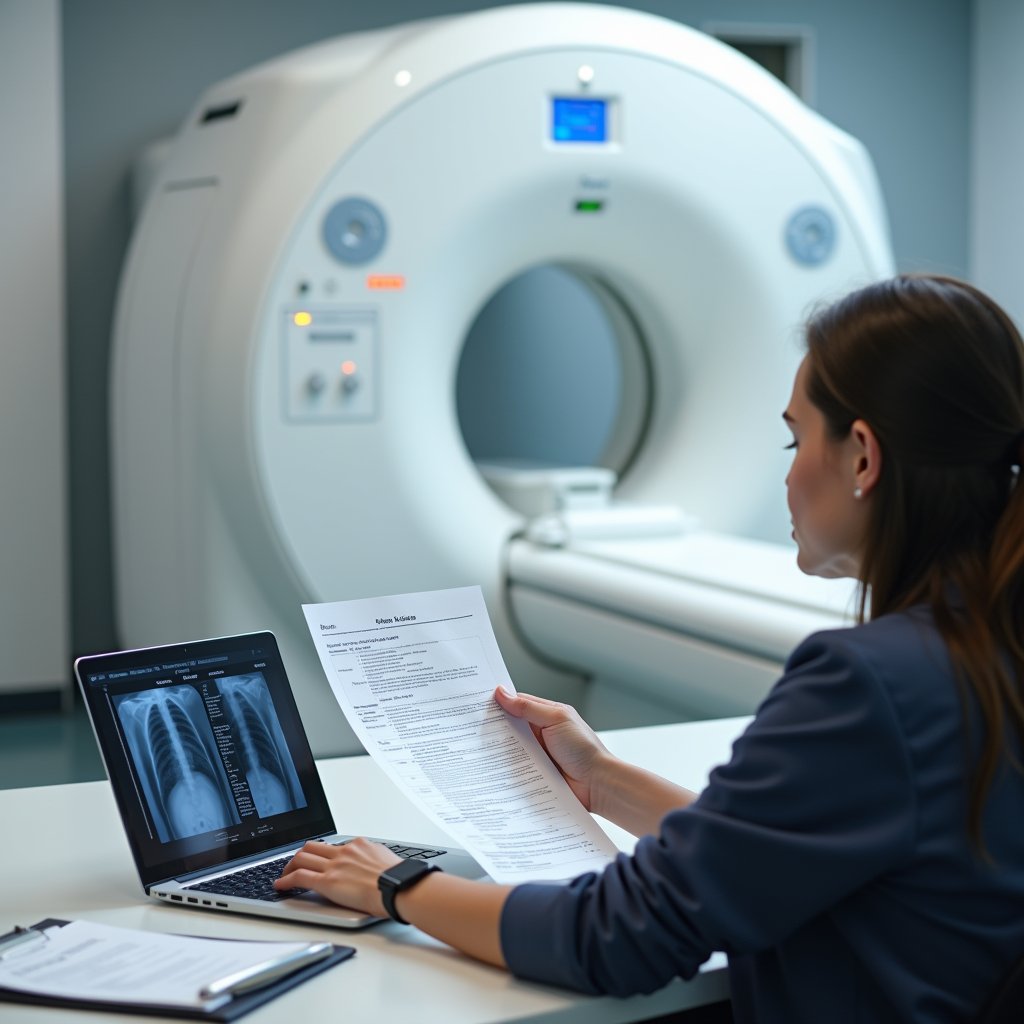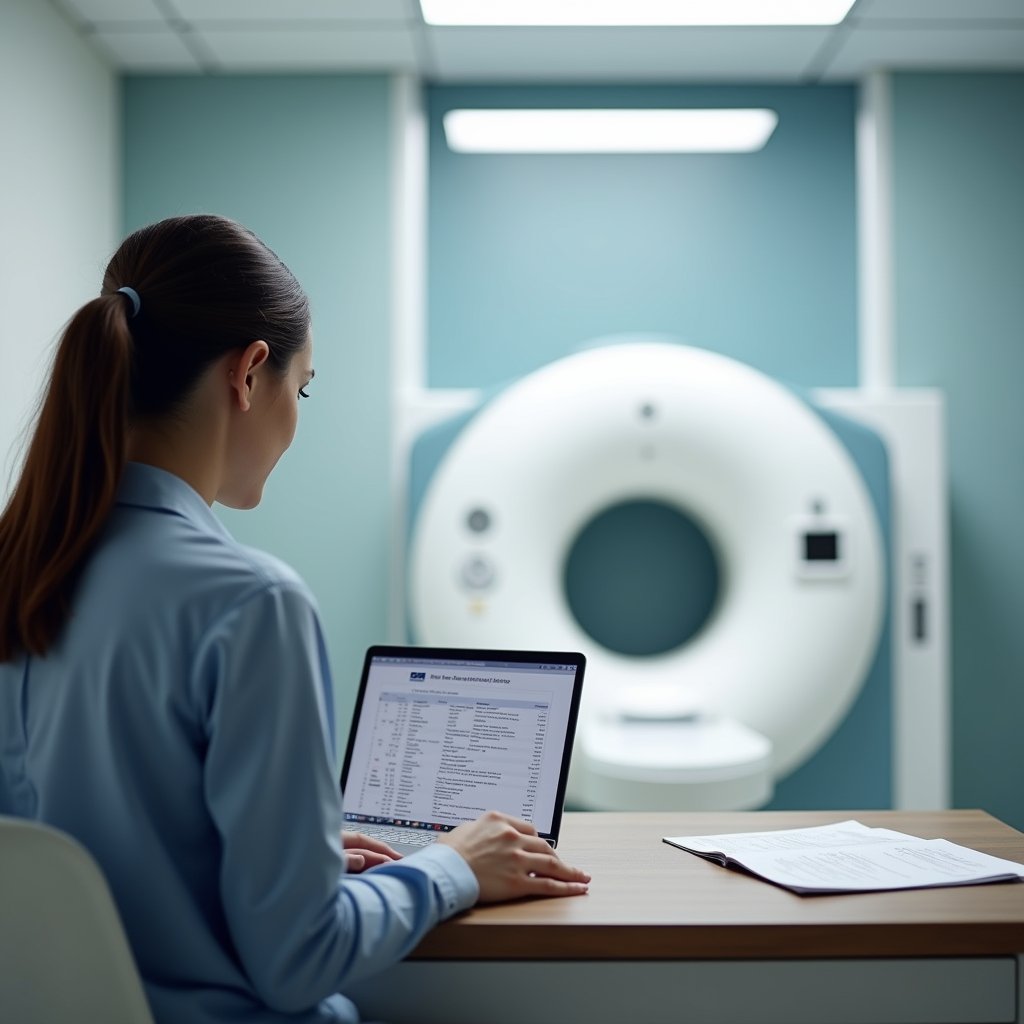CT scan costs with insurance vary widely based on your plan type and deductible status. With HDHPs, you’ll pay full costs ($500-$6,500) until meeting your deductible, then 10-30% coinsurance. Medicare covers 80% after a $257 deductible. In-network providers charge 30-60% less than out-of-network, and independent imaging centers cost considerably less than hospitals. Your body part scanned also impacts pricing, with cardiac scans being most expensive. The following sections break down specific factors affecting your final bill.
Insurance Plan Types and Their Impact on CT Scan Costs

Insurance plans greatly influence the out-of-pocket costs you’ll face for CT scans, with variations based on plan structure and coverage details.
High-Deductible Health Plans (HDHPs) offer lower monthly premiums but require you to meet substantial deductibles ($1,500–$7,000) before coverage activates, leaving you responsible for the full $500–$6,500 hospital CT scan cost until then.
Paying less monthly? Be prepared to cover the entire CT scan cost until meeting your high deductible.
Once you’ve met your deductible, expect to pay 10%–30% coinsurance with HDHPs.
Medicare operates differently, with Part B covering 80% of outpatient scans after a $257 deductible, while Medicare Advantage plans may offer $0 copays for in-network imaging (available in 45% of plans). CT scans in ambulatory centers often have lower costs than those performed in hospital outpatient departments, with costs such as $18 versus $27 for a head/brain CT scan.
Understanding your specific insurance plan benefits and deductible variations is essential, as out-of-network scans typically incur markedly higher costs. The cost can also vary significantly depending on which body part scanned you need imaged, with pelvic CT scans being among the most expensive options. Many patients choose outpatient facilities over hospitals to reduce their costs, as these settings typically charge less than hospital-based imaging centers.
In-Network vs. Out-of-Network Pricing Differences
Choosing in-network providers for CT scans greatly impacts your out-of-pocket costs. In-network facilities charge 30-60% less than out-of-network providers due to pre-negotiated insurer rates. While you’ll pay $25-$50 copays for in-network scans, out-of-network services can trigger 40-60% coinsurance plus balance billing for uncovered charges. Always verify coverage specifics with your insurance provider before scheduling your imaging exam. Reviewing your medical bills carefully is crucial as providers may submit out-of-network claims incorrectly. Prior authorization is often medically necessary for insurance to cover the cost of your CT scan.
| Cost Factor | In-Network | Out-of-Network |
|---|---|---|
| CT Scan Average | $300-$1,000 | $1,200-$6,750 |
| Patient Responsibility | Copay ($0-$50) | 40-60% Coinsurance |
| Prior Authorization | Usually Required | May Not Apply |
| Balance Billing | Not Permitted | Common Practice |
| Financial Assistance | Often Available | Rarely Offered (28%) |
Hospital-based scans cost 2-5 times more than identical procedures at independent imaging centers, with out-of-network charges reaching $12,913 versus $3,330 for comparable in-network services. Your insurer’s plan type markedly affects these in-network savings and out-of-network charges.
Understanding Prior Authorization and Medical Necessity Requirements

Before scheduling a CT scan, you’ll need to navigate the prior authorization process required by almost all insurers. This involves your physician submitting clinical evidence including exam notes and imaging reports on standardized forms to justify diagnostic necessity.
Prior authorization challenges include processing delays of 3-14 business days and potential claim denials without proper approval. Skipping this step may leave you fully responsible for costs. CT scan costs can vary significantly from $300 to $7,000 depending on geographic location and body part being scanned.
Bypassing prior authorization can result in costly out-of-pocket expenses and significant treatment delays.
Medical necessity documentation must demonstrate specific criteria: documented trauma, neurological deficits, failed conservative treatments, or suspected malignancy. Your physician must provide signed orders with matching ICD-10 codes, detailed progress notes, and prior imaging results. Remember that medical guidelines strongly advise against routine imaging for acute low back pain within the first six weeks unless specific red flags are present.
If denied, you can appeal with proper documentation 75% of initial denials are overturned.
How Body Part Scanned Affects Your Out-of-Pocket Expenses
The specific body part requiring CT imaging greatly influences your final out-of-pocket costs, with variations often exceeding 300% between different anatomical regions.
Extremity scans (arms/legs) represent the most affordable option at $270-$900 due to simpler imaging requirements and shorter scan complexity.
Brain CT scans command higher prices ($350-$4,800) because of detailed structural analysis needs, while cardiac imaging tops the expense chart at $625-$12,700 due to specialized equipment and expertise requirements.
Abdominal and pelvic scans fall between these ranges, with costs increasing by 30-50% when multiple areas require imaging in a single session. Neck CT scans typically cost between $1,000 to $7,600 depending on facility type and contrast material used.
The imaging duration directly affects pricing, with complex regions requiring more advanced protocols and longer scan times, subsequently increasing your financial responsibility. Insurance status can dramatically impact these costs, as insured individuals typically pay significantly less than those without coverage.
Many patients find it beneficial to compare facilities when scheduling their CT scan, as prices can vary substantially between imaging centers even within the same geographic area.
Hospital vs. Independent Imaging Center: Comparing Your Options

When maneuvering CT scan options with insurance coverage, you’ll face a significant financial decision between hospital facilities and independent imaging centers.
Independent centers typically charge $300–$3,280 versus hospitals’ $500–$20,000+ for identical services, with 60% lower costs for uninsured patients.
Choosing independent imaging centers saves 60% on identical CT scans that hospitals charge premium prices for.
Wait times illustrate independent benefits, with 87% of patients completing scans under 30 minutes versus hours-long hospital delays.
You’ll find extended hours, free parking, and paperless check-in at independents, while maintaining equivalent diagnostic accuracy. This convenience factor is enhanced by minimal navigation challenges compared to complex hospital layouts.
Insurance coverage differs dramatically: high-deductible plans require $3,000+ at hospitals versus $1,500 at independents before coverage kicks in. Medically necessary scans are usually covered by most health insurance policies, though patients may need to meet deductibles first.
Despite perceived hospital advantages like emergency access, independents offer specialized radiologists and lower infection rates (0.3% versus hospitals’ 2.1%) while using identical FDA-approved equipment. CT scans provide detailed 3D images that help physicians identify injuries, tumors, and various medical conditions more effectively than X-rays or ultrasounds.
Frequently Asked Questions
Can I Negotiate Lower CT Scan Costs With My Provider?
Yes, you can negotiate lower CT scan costs. Employ proven negotiation strategies like requesting self-pay discounts (20-40% at standalone centers), comparing facility prices (outpatient centers average $525 vs. hospitals at $4,750), and asking about bundled pricing.
Effective provider communication is essential directly discuss payment plans, inquire about off-peak scheduling discounts (10-15%), and request contrast-free options when medically appropriate.
Always verify if financial assistance programs apply to your situation.
How Quickly Can Insurance Approve an Urgent CT Scan?
Insurance typically approves urgent CT scans within 72 hours for expedited requests.
You’ll need to guarantee your physician submits clinical justification letters with diagnosis-specific evidence to speed up the process.
Plan type affects timelines PPO plans process urgent approvals 22% faster than HMOs, which require supplementary PCP referrals adding 24-48 hours.
Some insurers offer fast-track systems that bypass standard authorization procedures for life-threatening conditions encountered in urgent care settings.
Will Multiple CT Scans Affect My Annual Out-Of-Pocket Maximum?
Yes, multiple CT scans will impact your annual out-of-pocket maximum.
Each scan’s associated costs (deductibles, copays, coinsurance) accumulate in relation to your yearly limit. Once you reach your maximum capped at $8,850 for individuals in 2025 your insurance will cover 100% of remaining in-network services.
Multiple scans, especially those requiring contrast or performed at hospitals, will accelerate how quickly you reach this threshold due to their higher costs.
Are Contrast Agents Included in the Quoted CT Scan Price?
Contrast agents are typically not included in quoted CT scan prices.
They’re often billed separately using different CPT codes (like 70450 vs. 70470 for brain scans).
You’ll face $200-$1,200+ in extra costs depending on the agent type.
Insurance coverage varies most plans cover contrast when “medically necessary,” but you’ll need prior authorization.
Medicare Part B covers 80% after deductible.
Always ask specifically about contrast agent pricing before your procedure to avoid billing surprises.
Do Radiologist Consultation Fees Add to My Final CT Costs?
Radiologist fees typically contribute to your final CT costs, especially at hospitals where professional and technical fees are often billed separately.
Independent imaging centers usually include radiologist consultation costs in their all-inclusive pricing.
You’ll likely face separate charges at hospitals (ranging $150-$450) versus minimal or bundled fees at outpatient centers ($0-$125).
Insurance coverage varies most private insurers include these fees, but high-deductible plans require payment until you meet your deductible.
Out-of-network radiologists may trigger extra balance billing.

